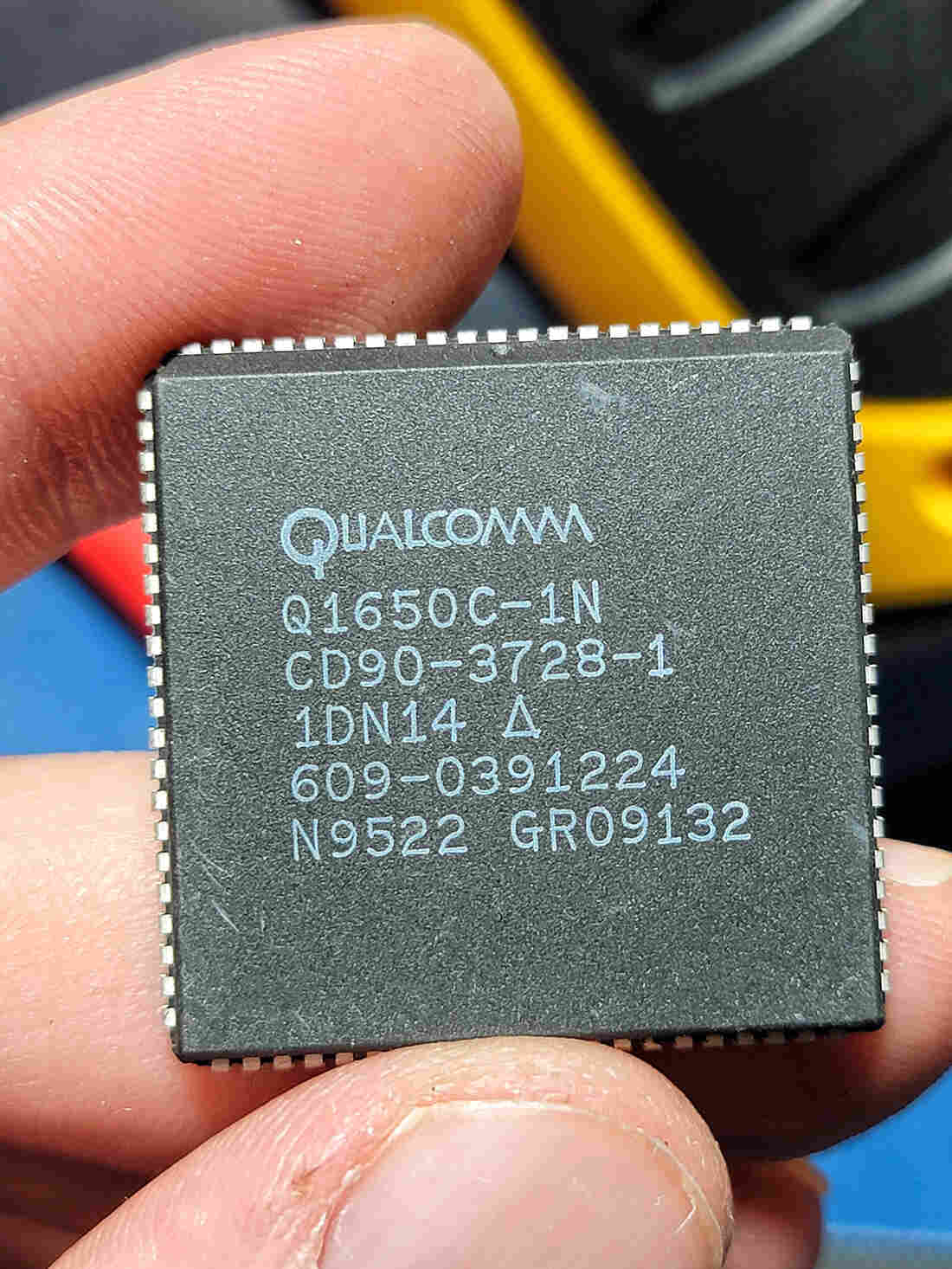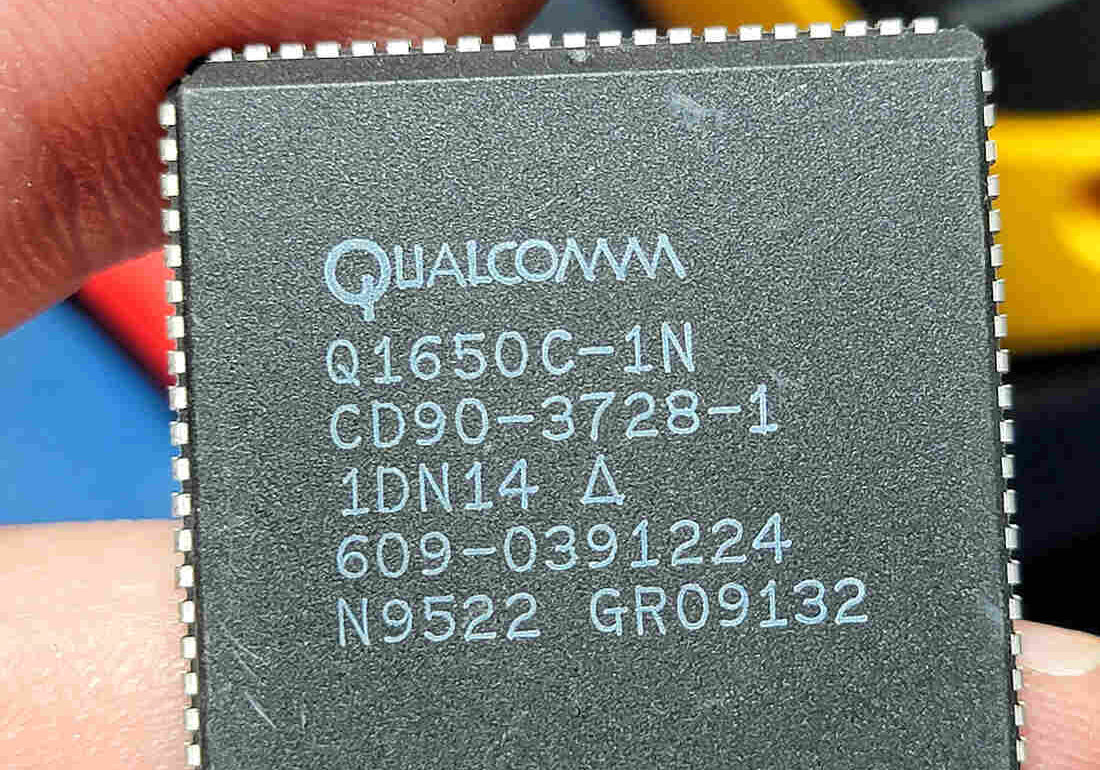
Kenton Smith designs circuit boards and has long been fascinated by computers. He was examining chips a few years ago when he found one smiling back up at him.
Courtesy of Kenton Smith
Courtesy of Kenton Smith
An owl. A sharky looking bullet. The Hindu deity Ganesh. The Yin and Yang sign. All painstakingly selected and etched onto a microchip that measures about an inch square. Each microscopic silicon doodle was the handiwork of engineers at Qualcomm Incorporated, a San Diego-based company that creates wireless technology-related products and services. The engineers slipped the drawings into Qualcomm’s Q1650 data decoder with care not to disturb any of the chip’s functions.
They were purposeless etchings, never meant to be uncovered.
These doodles, also known as silicon art, chip graffiti or chip art, and dozens others like it, are remnants of tech history—from Silicon Valley’s infancy to the early 2000s—when innovation was rapid fire and the tech still had a very human touch. Engineers would add the sketches to their microchip designs in the techie equivalent of signing their artwork. They’d etch them on chips that may end up in your cellphone, laptop or calculator. They spent hours crafting them, even though they were frowned upon by those in the C Suite.
The existence of these doodles came to light decades ago, but social media is discovering them anew. And there is now a small but determined group of online hobbyists working to keep that history alive. They are still cataloguing the miniscule drawings — many smaller than the width of a human hair and can’t be seen without a microscope.
These devotees post glossy videos of themselves shucking chips like oysters to see their iridescent insides and the itsy bitsy sketches that may be hidden on them. And they are eagerly saving them from the scrap heap.
“We did it for ourselves”
Richard Kerr spent 15 years at Qualcomm starting in the mid 1980s.
His first doodle was inspired by his then-4-year-old son, Jesse Kerr, who would ask to help with his chip designs.
“Well, he was into trucks at the time, so I designed a little ’56 Chevy pickup truck,” Kerr said.
@evilmonkeyzdesignz I’m sure I’m pronouncing Viterbi incorrectly. This chip is the Q1650C from Qualcomm, and is a Viterbi Decoder. It contains 7 #silicondoodle s. #ComponentsCloseUp #electronics #tech #technology #techtok #electricalengineering ♬ I Really Want to Stay at Your House – Slowed + Reverb – Lofitopía
Kerr only recently learned that others had discovered his decades-old doodles, from a friend who found a video on YouTube of the doodle packed Q1650 data decoder. “I was just blown away that somebody actually found it. And then it was like, you know, total memory lane,” he said.
“Mine is the shark bullet. Because my son (Jesse) was a body boarder at that time. And so he decided that that was cool because he saw it on somebody’s wetsuit,” Kerr said.
Many of the doodles came from engineers who weren’t doing it for an audience.
“We did it for ourselves,” said Willy McAllister, a retired electrical engineer who worked for more than a decade at Hewlett-Packard (HP) and helped craft a chip with the sleek image of a cheetah on it. “Nobody ever expected it to be cracked open 10 years later and marveled at. That was never the point.”
The cheetah was picked as a visual representation for an HP project code named after the world’s fastest land animal.
McAllister’s wife, Monica, sketched the cheetah, which was transferred to the chip. One of the big cat’s spots is about 4 microns across — far thinner than a sheet of paper.
Where’s Waldo?
So how did this tiny art make its debut? The late research scientist Michael W. Davidson who ran the optical microscopy laboratory at Florida State University for about decade until his retirement (and death) in 2015 had a microscope he used to photograph integrated circuits. One day in the late ’90s while scanning a circuit, he found Waldo. Or at least, the etched outline of Waldo’s head.
“Waldo is the first Silicon Creature that we discovered,” reads the Silicon Zoo website. “And this led to an exhaustive search for more creatures and construction of the Silicon Zoo gallery.”
Davidson built the Silicon Zoo website to record his findings and he was tireless in his search for this art.
“At one point, I would say in ’99 it was that the word was out in Tallahassee that we were collecting (chips),” said Eric Clark, who helped Davidson build the site. “We had a mountain of just computer parts and chips.”
The site has catalogued dozens of doodles, many that wink to the function of the integrated circuit, like an elephant on a memory chip, or a can o’ worms nodding to the many problems a designer faced.
But there are still more out there.
Preserving bits of tech history
That’s where people like Kenton Smith come in. Smith designs circuit boards and has long been fascinated by computers. He was examining chips a few years ago when he found one smiling back up at him.
“I was just opening up a bunch of different types of chips,” he said. “And eventually I came to one and it had a smiley face on it. And to find that was one of the best feelings I’ve ever had in the world.”
The discovery led him deep into the world of silicon scribbles, and he now buys bulk chip lots on eBay and regularly posts videos showcasing his finds.
“One of the the driving forces, I think, to buying so much stuff on eBay is that there’s always this feeling that if I don’t get it, I may never see that chip again,” Smith said. “And it’s going to be recycled and we’ll lose parts of our history.”
Smith posts about his finds across various social media, using his @Evilmonkeyzdesignz accounts that have hundreds of thousands of followers among them.
@evilmonkeyzdesignz check out this doodle of a dump truck 🚚 on a chip! #ComponentsCloseUp #electronics #technology #tech #techtok #dumptruck ♬ Uh Oh Stinky but It’s a Soft Lofi Beat – LLusion
This is a hobby that takes dedication. First you have to find the chips. Then you have to snip them from their casings. Sometimes the chips shatter into pieces. Sometimes acid is needed to eat away at decades old adhesive.
“I go to flea markets almost every week,” said the man behind the @CPU_Duke accounts. “I’m looking at boards and I get a feeling for this could be interesting, this is an interesting brand. Could have a doodle on it. An Easter egg.” He didn’t want to use his real name for privacy reasons.
The microscopic art scene
The doodles represent an amusing a collision of technology and art.
Albert Folch, a professor at the University of Washington’s bioengineering department, is an expert in the field. He has long merged science and art in a program he calls BAIT (Bringing Art Into Technology). The walls in his office are covered in colorful microfluid artwork, which blend scientific photography with artistic flourishes.
For Folch, the micro doodles are a joyful distraction.
“I think it’s a lot of fun,” he said. “When I was designing chips myself, I never did it. But I think it’s something that if it had occurred to me, I probably would have done it, just for fun.”
This post was originally published on this site be sure to check out more of their content








